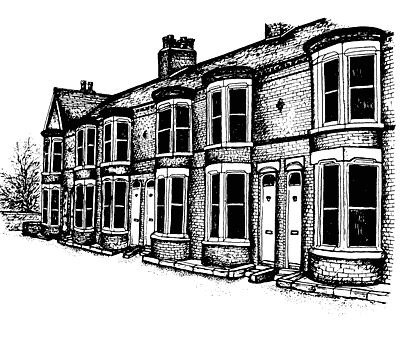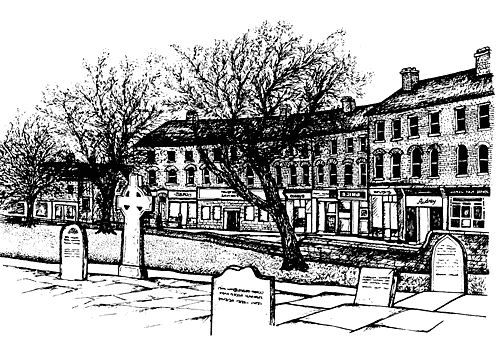Liverpool Conservation Areas 19 & 25
Wavertree Garden Suburb & Walton on the Hill
Introduction & Contents
CONSERVATION AREA 19
Wavertree Garden Suburb
The concept of Wavertree Garden Suburb owes it origins to the ideals of nineteenth century social reformers who, appalled by the housing conditions of their time, campaigned for a way of life based on community centred garden suburbs built to low densities enabling people to live in peaceful, pleasant and healthy surroundings. The Liverpool Garden Suburb Tenants Limited was founded in 1909 as a tenants' co-operative, capital and loan stock was raised, and the first 100 houses were completed and occupied by 1912. The houses were planned with a limitation of twelve to the acre, allowing ample space for the provision of individual gardens. Open spaces, a children's playground, tennis courts and a bowling green were included in the scheme, and many trees were planted in streets, hedgerows a^id gardens. In the decade before Worlds War 1 the Garden Suburb was visited by people from all parts of the country and overseas who praised its layout, house designs and the thriving community spirit of its residents.Wavertree Garden Suburb Conservation Area was designated on 22 December 1971.
 A contemporary journal contrasted the cottages and gardens of the Surburb with the terraced houses being built elsewhere.
A contemporary journal contrasted the cottages and gardens of the Surburb with the terraced houses being built elsewhere.The first part of the suburb to the west of Wavertree Nook Road was laid out in 1910 by Raymond Unwin, who, with his partner Barry Parker, designed such other influential Garden Suburbs as Letchworth, Hampstead, and New Earswick near York. G.I. Sutcliffe was the architect for the houses.

The Liverpool Daily Post and Mercury, 19th November 1913 reported:
'Each house has its own plot of ground for a garden - and is planned so that a maximum amount of light and sunshine may be put upon it. The living room or working room has the sunniest aspect generally. It is a feature of the builders to supply all the fittings necessary for the Electric Light.* 'The servant question has been solved largely by the introduction of many up-to-date internal arrangements for labour saving.
And before that, in 1911:
'The social life of the Liverpool Garden Suburb was appropriately inaugurated by a Garden Party held on Saturday July 1st. To the accompaniment of cheerful conversation, about eighty sat down to tea, provided by the Ladies' Committee, and served on one of the greens. The Garden Suburb Choir then made its first appearance. Such favourites as "Sweet and Low" and "Oh! who will o'er the Downs with me?" sounded more than ever delightful in the clear air.'
 'Two sessions have been held of the Open-air parliament, which, after the fashion of the old village fathers, meets on Saturday "evenings on the green", for the informal discussion "of matters of interest".
'Two sessions have been held of the Open-air parliament, which, after the fashion of the old village fathers, meets on Saturday "evenings on the green", for the informal discussion "of matters of interest".

Gardening topics have so far occupied attention, but local history and other matters will be treated by experts, and discussed with the freedom which a comfortable seat and a pipe in the open air engender'
Top

CONSERVATION AREA 25
Walton on the Hill
 St. Mary, the parish church of Walton, has an ancient foundation, and was, until 1699, the parish church for Liverpool. However, no pre-nineteenth century architectural features survive, the earliest part of the present building being the west tower, designed by John Broadbent and built in 1828-32.
St. Mary, the parish church of Walton, has an ancient foundation, and was, until 1699, the parish church for Liverpool. However, no pre-nineteenth century architectural features survive, the earliest part of the present building being the west tower, designed by John Broadbent and built in 1828-32.The oldest building in the Conservation Area is the Old School House built in the early seventeenth century with its well preserved masonry walls and stone flagged roof. The next oldest artifact is the sundial in the churchyard, which dates from the late seventeenth century. Also included are the Victorian crescent of shops fronting County Road, the red brick baths, the new and old Rectories, the Vicarage and two attractive terraces of houses in Walton Village. The buildings have in the main been well kept and little altered.
Walton-on-the-Hill Conservation Area was designated on 17 November 1976

St. Mary's church, with the sun dial in front of the porch »
Penuel Road (below) is a short cul-de-sac of well-built late Victorian small houses, in red pressed brick with stone bays.


The Victorian shops on the curve of County Road follow the old line of the churchyard.